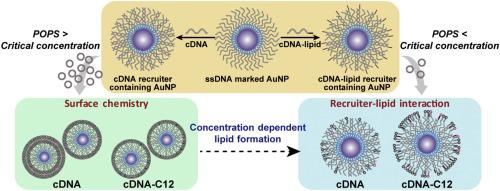Colloids and Surfaces B: Biointerfaces ( IF 5.4 ) Pub Date : 2021-08-30 , DOI: 10.1016/j.colsurfb.2021.112084 Jeehae Shin 1 , Sheng Li 1

|
Biofunctional interfaces containing DNA-conjugated molecules have been explored for various bioengineering applications. However, there is still a lack of understanding of the interaction between DNA conjugates and surrounding biomolecules. In this study, we prepare DNA-containing recruiter molecules and incorporate them onto DNA immobilized gold nanoparticles through DNA hybridization. Liposomes composed of different phospholipids are then applied to investigate supported lipid layer formation on these recruiter-containing surfaces. We find that the morphology and the amount of lipid layers formed are determined by both the liposome concentration and the type of recruiter molecule. When liposomes are applied in excess above a critical concentration, surface chemistry determines the lipid layers formed, leading to lipid multilayers on hydrophilic DNA recruiter containing surfaces and lipid monolayers on hydrophobic DNA-lipid recruiter containing surfaces. When the liposome concentration is below the critical value, the surface molecules take on a more direct role and recruit lipids through hydrophobic interaction. The total amount of the lipid layers formed is further modulated by the overall charge and the fluidity of the liposomes applied. These results provide quantitative analysis on the interaction of DNA conjugates with lipid molecules and introduce a new approach to fine-tune lipid layer formation behavior.
中文翻译:

使用含 DNA 的募集分子调节颗粒表面脂质层的形成
已经为各种生物工程应用探索了包含 DNA 共轭分子的生物功能界面。然而,人们对DNA偶联物与周围生物分子之间的相互作用仍缺乏了解。在这项研究中,我们制备了含有 DNA 的招募分子,并通过 DNA 杂交将它们整合到 DNA 固定的金纳米粒子上。然后应用由不同磷脂组成的脂质体来研究这些含有募集剂的表面上支持的脂质层形成。我们发现形成的脂质层的形态和数量由脂质体浓度和募集分子的类型决定。当脂质体过量使用超过临界浓度时,表面化学决定了形成的脂质层,导致含有表面的亲水性 DNA 募集剂的脂质多层和含有疏水性 DNA-脂质募集剂的表面上的脂质单层。当脂质体浓度低于临界值时,表面分子将发挥更直接的作用,并通过疏水相互作用招募脂质。所形成的脂质层的总量进一步受到所施加脂质体的总电荷和流动性的调节。这些结果提供了对 DNA 偶联物与脂质分子相互作用的定量分析,并引入了一种微调脂质层形成行为的新方法。表面分子扮演更直接的角色,并通过疏水相互作用招募脂质。所形成的脂质层的总量进一步受到所施加脂质体的总电荷和流动性的调节。这些结果提供了对 DNA 偶联物与脂质分子相互作用的定量分析,并引入了一种微调脂质层形成行为的新方法。表面分子扮演更直接的角色,并通过疏水相互作用招募脂质。所形成的脂质层的总量进一步受到所施加脂质体的总电荷和流动性的调节。这些结果提供了对 DNA 偶联物与脂质分子相互作用的定量分析,并引入了一种微调脂质层形成行为的新方法。











































 京公网安备 11010802027423号
京公网安备 11010802027423号